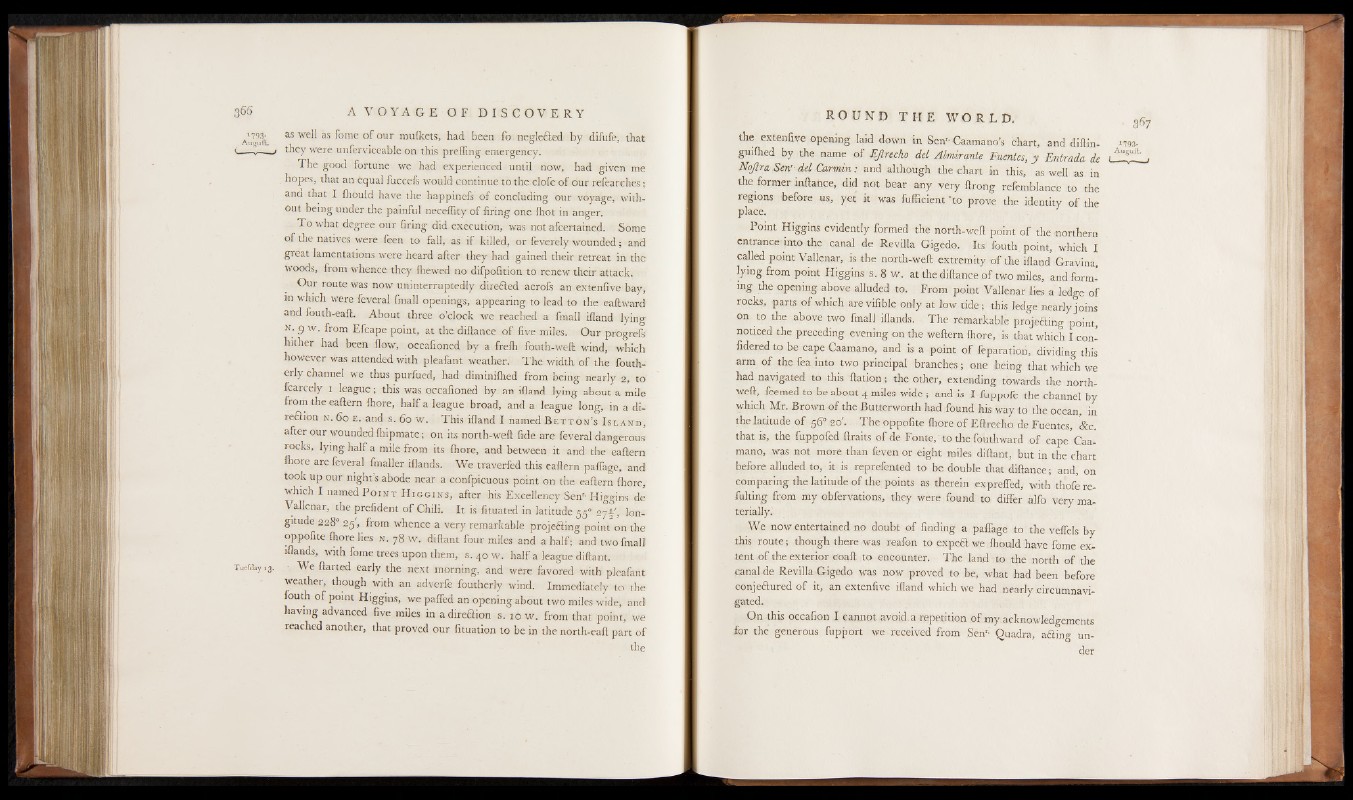
Au7u3ii. as wel1 as 1°me o f our mufkets, had been foneglefted by difufe, that
i_— 3—_/ they were unferviceable on this preffing emergency.
The good fortune we had experienced until now, had given me
hopes, that an equal fuccefs would continue to the clofeof our refearches;
and that I [hould have the happinefs of concluding our voyage, without
being under the painful neceffity o f firing one fhot in anger.
T o what degree our firing did execution, was not afcertained. Some
o f the natives were feen to fall, as if killed, or feverely wounded; and
great lamentations were heard after they had gained their retreat in the
woods, from whence they {hewed no difpofition to renew their attack.
Our route was now uninterruptedly diredled aerofs an extenfive bay,
in which were feveral fmall openings, appearing to lead to the eaflward
and fouth-eaft. About three o’clock we reached a fmall ifland lying
N. 9 w. from Efcape point, at the diftance of five miles. Our progrefs
hither had been flow, occafioned by a frefh fouth-weft wind, which
however was attended with pleafant weather. The width of the fouth-
erly channel we thus purfued, had diminifhed from being nearly 2, to
fcarcely x league; this was occafioned by an ifland lying about a mile
from the eaflern fhore, half a league broad, and a league long, in a di-
re&ion n. 6o e. and s. 6o w . This ifland I named B e t t o x ’s I s l a n d ,
after our wounded fhipmate; on its north-weft fide are feveral dangerous
rocks, lying half a mile from its fhore, and between it and the eaftern
fhore are feveral fmaller iflands. We traverfed this eaftern paflage, and
took up our night’s abode near a confpicuous point on the eaftern fhore,
which I named P oin t H ig g in s , after his Excellency Sen’-Higgins de
Vallenar, the prefident of Chili. It is fituated in latitude 55- ayi-', longitude
228° 25', from whence a very remarkable projefting point on the
oppofite fhore hes n. 78 w , diftant four miles and a half; and two fmall
iflands, with fome trees upon them, s. 40 w. half a league diftant.
Tuefday 13. We ftarted early the next morning, and were favored with pleafant
weather, though with an adverfe fbutherly wind. Immediately to the
fouth of point Higgins, we paffed an opening about two miles wide, and
having advanced five miles m a direction s. 10 w . from that point, we
reached another, that proved our fituation to be in the north-eaft part of
the
R O U N D T H E W O R L D .
the extasfite opening laid down in Sen'- Caamano’s chart, and diftin- *79»
guifhed by the name o f EJirecho del Almirante Fuentes, y Entrada de ' AuS.Ult'.
Nojlra Sen'- del Carrnn: and although the chart in this, as well as in
the former inftance, did not bear any very ftrong refemblance to the
regions before us, yet it was fufficient 'to prove the identity of the
place.
Point Higgins evidently formed the north-weft point o f the northern
entrance-into the canal de Revilla Gigedo. Its fouth point, which I
called point Vallenar, is the north-weft extremity o f the ifland Gravina,
lying from point Higgins s. 8 w. at the diftance of two miles, and forming
the opening above .alluded to. From point Vallenar lies a ledge of
rocks, parts o f which are vifible only at low tide; this ledge nearly joins
on to the above two fmall iflands. The remarkable projefiing -point,
noticed the preceding evening on the weftern fhore, is that which I con-
fidered to be cape Caamano, and is a point of feparatiori, dividing this
arm o f the fea into two principal branches; one being that which we
had navigated to this ftation; the other, extending towards the north-
weft, feemed to be about 4 miles wide ; and is I fuppofe the channel by
which Mr. Brown o f the Butterworth had found his way to the ocean, in
the latitude o f 56° 20'. The oppofite fhore o f Eftrecho de Fuentes, A c .
that is, the fuppofed ftraits of de Fonte, to the fouth ward o f cape Caamano,
was not more than feven or eight miles diftant, but in the chart
before alluded to, it is reprefented to be double that diftance; and, on
comparing the latitude of the points as therein expreffed, with thofe re-
fulting from my obfervations, they were found to differ alfo very materially.'
We now entertained no doubt o f finding a paflage to the veffels by
this route; though there was reafon to expeft we fhould have fome extent
of the exterior c'oaft to encounter. The land to the north of the
canal de Revilla Gigedo was now proved to he, what had been before
conjectured of it, an extenfive ifland which we had nearly circumnavigated.
On this oecaiion I cannot avoid a repetition o f my acknowledgements
for the generous fupport we received from Sen': Quadra, afting under